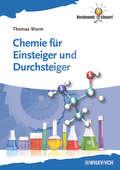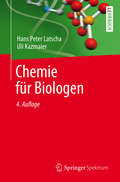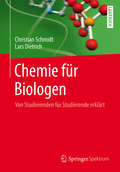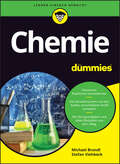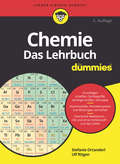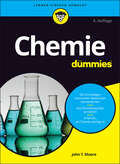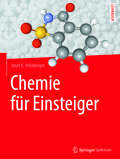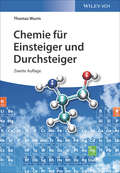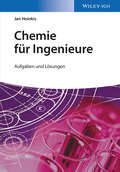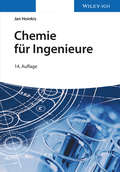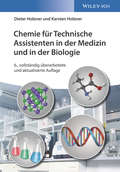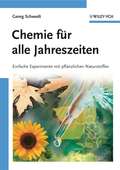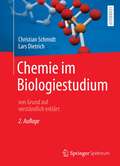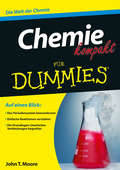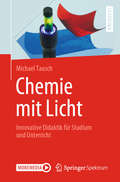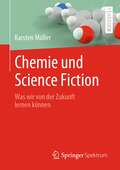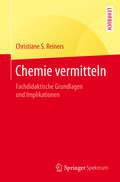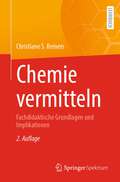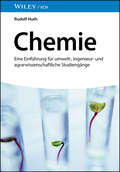- Table View
- List View
Chemie fur Einsteiger und Durchsteiger (Wiley-VCH-Lehrbuchkollektion 2)
by Thomas WurmKompakt und 'verdammt clever' auf den Punkt gebracht - vermittelt dieses Einsteiger-Buch das unverzichtbare chemische Grundwissen für 'Chemie-Nebenfächler'. Die Studenten können sowohl Studenten der Lebenswissenschaften (Medizin, Biologie) als auch technischer Fachrichtungen (z.B. Maschinenbau, Umwelttechnik...) sein. Mit dem didaktischen Ansatz, zuerst Problemstellung - dann Antwort, fördert das Buch die aktive Auseinandersetzung mit dem Stoff. Mit dem Blick aufs Wesentliche gerichtet, sind alle Hauptthemen der anorganischen und organischen Chemie äußerst verständlich erklärt und abgedeckt. Dabei unterstützen besondere Textelemente Ihren Lernerfolg: * Für inhaltliche Orientierung sorgen optisch hervorgehobene Schlüsselthemen am Kapitelanfang. * Das Wichtigste wird kurz und prägnant in Definitionen und Merksätzen zusammengefasst. * Beispiele helfen beim Anwenden des Lernstoffs. * Wissenstest und Prüfungsvorbereitung: Aufgaben mit Lösungen helfen ungemein beim eigenständigen Überprüfen des Gelernten.
Chemie für Biologen
by Uli Kazmaier Hans Peter LatschaDieses Lehrbuch bietet den Studierenden der Biologie alle Lerninhalte des Grundstudiums für das Fach Chemie. Es vermittelt den Lesern chemische Grundbegriffe und Grundreaktionen, die für das Verständnis der Biochemie, auf die besonders die neuen Biologie-Studiengänge ausgerichtet sind, unerlässlich sind. Leicht können einzelne Themenblöcke unabhängig voneinander gelernt werden. Darüber hinaus werden vor allem Biologie-relevante Bereiche vertieft, z. B. in einem eigenen Kapitel die verschiedenen Klassen von Naturstoffen, ihr Vorkommen und ihre "typische Chemie". In der vierten Auflage ist der organische Teil ausgebaut und die Struktur des gesamten Buches wurde übersichtlicher gestaltet.
Chemie für Biologen: Von Studierenden für Studierende erklärt
by Christian Schmidt Lars DietrichChemie hast du noch nie so richtig verstanden? Du hast Dein Studium der Biologie begonnen, aber hast leichten oder großen Respekt vor der damit verknüpften Chemie? Schätzt du dein Vorwissen in Chemie als unzureichend ein? Hast du vielleicht sogar gar kein Vorwissen in Chemie? Keine Sorge! In diesem Buch erklären wir dir die Grundlagen der Chemie - ausführlich und direkt von Studi zu Studi. Wir greifen auf unsere eigenen Erfahrungen als Tutoren für Biologie-Studierende im Fach Chemie zurück, und wir erinnern uns selbst noch gut an so manche gedankliche Hürde beim Lernen. Diese Hürden möchten wir für dich einreißen und führen dich somit von den grundlegenden Anfängen bis hin zu einem soliden Verständnis durch die Welt der Chemie - egal für wie ahnungslos du dich jetzt noch halten magst. In zahlreichen Beispielen aus dem Fach Biologie zeigen wir dir dabei, warum Chemie für Biologie-Studierende wichtig ist. Wir möchten, dass du Chemie verstehen lernst und nach der Lektüre dieses Buches Spaß daran hast, tiefergehenden Fragestellungen aus der Chemie auf den Grund zu gehen. Denn mit einem guten Verständnis für Chemie wird jede Beschäftigung mit der Biologie erst besonders spannend - egal ob du Biologie studierst, in einem im weitesten Sinne biowissenschaftlich orientierten Studiengang eingeschrieben bist oder ob du eine Ausbildung mit biowissenschaftlichen Inhalten absolvierst. Wirf einen Blick ins Buch und finde heraus, was es alles zu entdecken gibt.
Chemie für Dummies (Für Dummies)
by Michael Brandl Stefan ViehbeckDie Grundlagen der Chemie einfach erklärt In diesem Buch finden Sie alles, was Sie benötigen, um Chemie von Grund auf zu verstehen. Michael Brandl und Stefan Viehbeck erklären Ihnen leicht verständlich und mit vielen Beispielen aus dem Alltag die Grundlagen der Chemie: angefangen bei Aggregatzuständen und Atomen über Bindungen und chemische Reaktionen bis hin zu komplexeren Themen wie der organischen Chemie. Abbildungen und Formeln in Farbe erleichtern Ihnen das einfache Nachvollziehen von chemischen Vorgängen. Mithilfe von Versuchen und Aufgabenstellungen können Sie das Gelernte auch praktisch üben. Sie erfahren Wie das Periodensystem der Elemente aufgebaut ist Welche chemischen Bindungen es zwischen Atomen gibt Was es mit Wechselwirkungen und Redoxreaktionen auf sich hat Warum sich in der organischen Chemie alles um ein Element dreht
Chemie für Dummies: Das Lehrbuch (Für Dummies)
by Stefanie Ortanderl Ulf RitgenChemie ist viel einfacher, als es häufig heißt. Dieses Buch soll dazu beitragen, ihr Interesse an diesem Fach zu wecken oder zu vertiefen. Alle grundlegenden Prinzipien der Chemie werden nachvollziehbar dargestellt. Querbezüge und Zusammenhänge zwischen den verschiedenen Fachgebieten werden gezeigt. Sie werden keine Formel finden, deren Herleitung Sie nicht nachvollziehen können. Am Ende fast jeden Kapitels gibt es Übungsaufgaben. Ausführliche Lösungen gibt es natürlich auch. Das sollte nicht nur für die Prüfungen der ersten Semester reichen, sondern Ihnen auch ein sicheres Fundament für Ihr weiteres Studium bieten.
Chemie für Dummies: So Stimmt Ihre Chemie Mit Der Chemie (Für Dummies)
by John T. MooreWenn es knallt und stinkt, dann ist Chemie im Spiel! "Chemie für Dummies" macht deutlich, dass Chemie nicht nur aus Formeln, sondern vor allem aus unzähligen interessanten Stoffen, Versuchen und Reaktionen besteht. In diesem etwas anderen Chemie-Buch lernen Sie die Grundlagen der Chemie kennen und erfahren, wo sich chemische Phänomene im Alltag bemerkbar machen. John T. Moore macht für Sie so schwer vorstellbare Begriffe wie Atom, Base oder Molekül begreiflich und zeigt, wie man mit dem Periodensystem umgeht. Mit Übungsaufgaben am Ende eines jeden Kapitels können Sie dann noch Ihr Wissen überprüfen.
Chemie für Einsteiger
by Josef K. FelixbergerDas Buch ist eine leicht verständliche Einführung in die Welt der Chemie mit hohem praktischem Nutzen, angereichert mit zahlreichen anschaulichen Beispielen aus Alltag, Industrie, Wirtschaft, Politik und Geschichte. Eine reich bebilderte Darstellung der Allgemeinen und Anorganischen Chemie, der Organischen Chemie und Biochemie und last, but not least der Polymerchemie und Kunststoffverarbeitung. Gleichermaßen empfehlenswert für Studienanfänger mit Nebenfach Chemie, für Kaufleute und Techniker, Schüler und Lehrer sowie für interessierte Laien.
Chemie für Einsteiger und Durchsteiger
by Thomas WurmKompakt und 'verdammt clever' auf den Punkt gebracht - vermittelt dieses Einsteiger-Buch das unverzichtbare chemische Grundwissenfür 'Chemie-Nebenfächler'. Die Studenten können sowohl Studenten der Lebenswissenschaften (Medizin, Biologie) als auch technischer Fachrichtungen (z.B. Maschinenbau, Umwelttechnik...) sein. Mit dem didaktischen Ansatz, zuerst Problemstellung - dann Antwort, fördert das Buch die aktive Auseinandersetzung mit dem Stoff.Mit dem Blick aufs Wesentliche gerichtet, sind alle Hauptthemen der anorganischen und organischen Chemie äußerst verständlich erklärt und abgedeckt. Dabei unterstützen besondere Textelemente Ihren Lernerfolg:* Für inhaltliche Orientierung sorgen optisch hervorgehobene Schlüsselthemen am Kapitelanfang.* Das Wichtigste wird kurz und prägnant in Definitionen und Merksätzen zusammengefasst.* Beispiele helfen beim Anwenden des Lernstoffs.* Wissenstest und Prüfungsvorbereitung: Aufgaben mit Lösungen helfen ungemein beim eigenständigen Überprüfen des Gelernten.
Chemie für Einsteiger und Durchsteiger
by Thomas WurmDie zweite Auflage dieses beliebten Einsteiger-Buches vermittelt das unverzichtbare chemische Grundwissen für 'Chemie-Nebenfächler'. Die Studenten können sowohl Studenten der Lebenswissenschaften (Medizin, Biologie) als auch technischer Fachrichtungen (z.B. Maschinenbau, Umwelttechnik...) sein. Mit dem didaktischen Ansatz, zuerst Problemstellung - dann Antwort, fördert das Buch die aktive Auseinandersetzung mit dem Stoff. Kompakt und auf den Punkt gebracht sind alle Hauptthemen der anorganischen und organischen Chemie äußerst verständlich erklärt und abgedeckt. Dabei unterstützen besondere Textelemente Ihren Lernerfolg: * Für inhaltliche Orientierung sorgen optisch hervorgehobene Schlüsselthemen am Kapitelanfang. * Das Wichtigste wird kurz und prägnant in Definitionen und Merksätzen zusammengefasst. * Beispiele helfen beim Anwenden des Lernstoffs. * Wissenstest und Prüfungsvorbereitung: Aufgaben mit Lösungen helfen ungemein beim eigenständigen Überprüfen des Gelernten.
Chemie für Ingenieure
by Jan HoinkisDer Prüfungstrainer zum Lehrbuch "Chemie für Ingenieure" hilft dank praxisrelevanter Aufgaben und ausführlicher Lösungen beim Bestehen von Klausuren und Prüfungen.
Chemie für Ingenieure
by Jan HoinkisDie 14. Auflage dieses Klassikers bietet eine umfassende praxisorientierte Einführung in die für Ingenieure relevante Chemie. Vollständig überarbeitet und aktualisiert ist das Buch besonders für Ingenieure in Bachelor- und Diplomstudiengängen konzipiert.
Chemie für Ingenieure: Aufgaben und Lösungen
by Jan HoinkisDer Prüfungstrainer zum Lehrbuch "Chemie für Ingenieure" hilft dank praxisrelevanter Aufgaben und ausführlicher Lösungen beim Bestehen von Klausuren und Prüfungen.
Chemie für Mediziner für Dummies
by Bernd GoldfußWenn Sie sich fur ein Medizinstudium entschieden haben, mussen Sie sich auch mit der Chemie auseinandersetzen. Aber keine Sorge, dieses Buch bereitet Sie optimal auf die anstehende Prufung vor. "Chemie fur Mediziner fur Dummies" erklart Ihnen anschaulich, wie ein Atom aufgebaut ist, welche Arten der chemischen Bindung es gibt, was Komplexverbindungen sind und fuhrt Sie in die Organische Chemie und die Chemie der Naturstoffe ein. Bernd Goldfu? erklart Ihnen alles, was Sie als Mediziner uber die Chemie wissen mussen - von der Struktur von Penicillin bis zu den chemischen Phanomenen, die der Dialyse zugrunde liegen.
Chemie für Technische Assistenten in der Medizin und in der Biologie
by Dieter Holzner Karsten HolznerDer "Holzner" ist und bleibt das beliebteste Chemie-Lehrbuch für MTAs und BTAs. Auch die 6. Auflage beschränkt sich auf das Wesentliche der offiziellen Lehrpläne - ein Plus, das das Buch für Lehrende und Lernende so verlässlich macht.
Chemie für alle Jahreszeiten: Einfache Experimente mit pflanzlichen Naturstoffen
by Georg SchwedtMit bewahrt einfachen Experimenten fuhrt Erfolgsautor Georg Schwedt seine Leser diesmal durch die vier Jahreszeiten. Gegenstand der Versuche in seinem neuen Buch sind die jahreszeitlich typischen Pflanzen und ihre naturlichen Inhaltsstoffe. Anschaulicher als mit der bunten Welt der pflanzlichen Farb- und Geschmacksstoffe lasst sich Chemie kaum vermitteln. Obendrein werden auch Aspekte der allgemeinen Botanik und der Heilpflanzenkunde dargestellt. Bei allen Experimenten werden sowohl die Durchfuhrung als auch der naturwissenschaftliche Hintergrund verstandlich erlautert. Die Experimente konnen uberwiegend auch im Freien durchgefuhrt werden, dort wo die Pflanzen wachsen. Die Beschreibung der Experimente ist angereichert mit Informationen zur Kulturgeschichte der einzelnen Pflanzen sowie mit ausgewahlten Gedichten. Damit eignet sich das Buch besonders fur einen spannenden, facherubergreifenden Unterricht. Die wesentlichen Gruppen pflanzlicher Inhaltsstoffe erlautert Georg Schwedt in einem einfuhrenden Kapitel. Lassen auch Sie sich faszinieren von Scharbockskraut und Lowenzahn, Madesu? und Immergrun! Nach einem Chemie-Studium war Georg Schwedt zunachst Abteilungsleiter am Chemischen Untersuchungsamt Hagen, wechselte danach an die Universitat Gottingen und wurde anschlie?end Direktor des Institutes fur Lebensmittelchemie und Analytische Chemie der Universitat Stuttgart. Von 1987 bis 2006 war er Professor fur Anorganische und Analytische Chemie an der TU Clausthal. Georg Schwedt entwickelte das Mitmachlabor SuperLab und ist mit seinen zahlreichen Experimentalvortragen zur Chemie von Supermarktprodukten, historischer Chemie und weiteren Themen bundesweit bekannt. Zweimal wurde er vom Stifterverband der Deutschen Wissenschaft im Forderprogramm Wissenschaft im Dialog ausgezeichnet. Er ist Autor zahlreicher Sach- und Lehrbucher. Bei Wiley-VCH erschienen unter anderem: Was ist wirklich drin? - Produkte aus dem Supermarkt; Vom Tante-Emma-Laden zum Supermarkt - Eine Kulturgeschichte des Einkaufens; Experimente rund ums Kochen, Braten, Backen; Experimente mit Supermarktprodukten - Eine chemische Warenkunde; Chemische Experimente in Schlossern, Klostern und Museen - Aus Hexenkuche und Zauberlabor.
Chemie im Biologiestudium: von Grund auf verständlich erklärt
by Christian Schmidt Lars DietrichDu hast dein Studium der Biologie begonnen, aber hast leichten oder großen Respekt vor der damit verknüpften Chemie? Schätzt du dein Vorwissen in Chemie als unzureichend ein oder hast gar kein Vorwissen? Keine Sorge! In diesem Buch erklären wir dir die Grundlagen der Chemie – ausführlich und zugeschnitten auf die Bedürfnisse von Biolog*innen. Wir erinnern uns gut an so manche gedankliche Hürde beim Chemielernen. Diese Hürden möchten wir für dich einreißen und führen dich somit von den grundlegenden Anfängen bis hin zu einem soliden Verständnis durch die Welt der Chemie – egal für wie ahnungslos du dich jetzt noch halten magst. Mit zahlreichen Beispielen aus dem Fach Biologie zeigen wir dir, warum Chemie so wichtig ist. Wir möchten, dass du Chemie verstehen lernst und nach der Lektüre dieses Buches Spaß daran hast, tiefergehenden Fragestellungen aus der Chemie auf den Grund zu gehen. Denn mit einem guten Verständnis für Chemie wird jede Beschäftigung mit der Biologie erst besonders spannend – egal ob du ein Fach in den Life Sciences studierst oder ob du eine Ausbildung mit biowissenschaftlichen Inhalten absolvierst. Wirf einen Blick ins Buch und finde heraus, was es alles zu entdecken gibt.
Chemie kompakt fur Dummies (Für Dummies)
by John T. MooreEin solides Fundament ist die beste Basis allen Wissens: Das ist zwar eine Binsenweisheit, trotzdem fehlt es bei vielen Menschen in den Naturwissenschaften gerade an diesem Fundament. »Chemie kompakt für Dummies« schafft da Abhilfe. Hier erfahren Sie das Wichtigste zu den Elementen, Molekülen, Reaktionen, dem Periodensystem und vielem mehr. Nach seinem Bestseller »Chemie für Dummies« gibt Ihnen John T. Moore hier einen schnellen und doch fundierten Überblick über die Welt der Atome, Aggregatzustände und Co.
Chemie kompakt für Dummies (Für Dummies)
by John T. MooreEin solides Fundament ist die beste Basis alles Wissens: Das ist zwar eine Binsenweisheit, trotzdem fehlt es bei vielen Menschen in den Naturwissenschaften gerade an diesem Fundament. "Chemie kompakt für Dummies" schafft da Abhilfe. Hier erfahren Sie das Wichtigste zu den Elementen, dem Ablauf von Reaktionen, dem Aufbau des Periodensystems und vielem mehr. Das Buch enthält die wichtigsten Grundlagen der Chemie, angefangen bei einfachen Konzepten, wie Materie, bis hin zu komplexeren Themen, wie der organischen Chemie. Auch alltägliche Themen, wie die Fraktionierung von Rohöl oder die Entstehung von Luftverschmutzung, kommen nicht zu kurz. Nach seinem Bestseller "Chemie für Dummies" gibt Ihnen John T. Moore hier einen schnellen und doch fundierten Überblick über die Welt der Atome, Aggregatzustände und Co.
Chemie mit Licht: Innovative Didaktik für Studium und Unterricht
by Michael TauschDieses Lehrbuch vermittelt die Photochemie als innovatives und vielseitiges Konzept für die Gestaltung eines modernen und nachhaltigen Chemieunterrichts. Es ist eine absolute Pflichtlektüre für aktive Chemielehrer und Lehramtsstudierende und mit seinen Experimenten auf das 21. Jahrhundert ausgerichtet.
Chemie und Literatur: ein ungewohnlicher Flirt (Erlebnis Wissenschaft)
by Georg SchwedtGeorg Schwedts Bucher, in denen er chemische Elemente und Prozesse im Alltag aufspurt und spannende Experimente daraus entwickelt, sind Bestsellergaranten. "Chemie in der Weltliteratur" verbindet Schwedts Leidenschaft fur das Stoffliche mit der fur die Literatur. Seit seinen Studientagen liest er sich begeistert durch die gro?en Werke der Literatur: naturlich mit einem besonderen Blick fur alles Chemische. In seiner gro?en Gesamtschau findet sich Einschlagiges wie Goethes "Wahlverwandtschaften": Das zentrale Motiv, wie die Hauptfiguren sich voneinander entfernen und wieder neu finden, lasst sich ubertragen auf die Anziehungskrafte von chemischen Stoffen, die neue Verbindungen eingehen. Aus Aldous Huxleys dusterer Zukunftsvision "Schone neue Welt" zitiert er Abschnitte uber chemische Verwertungsprozesse oder das Klonen von Embryonen und erklart die Hintergrunde. Nicht fehlen darf naturlich die Geschichte von Jean-Baptiste Grenouilles aus Patrick Suskinds Erfolgsroman "Das Parfum". Die Experimente des genialischen Parfumeurs und Morders kann der Leser hier 1:1 nachvollziehen. Die spannende Reise durch die Welt der Literatur enthalt daruber hinaus Kapitel u. a. zu Buchners "Woyzeck", dem "Zauberberg" und "Doktor Faustus" von Thomas Mann oder auch zu Ecos "Der Name der Rose". Das ist ein ganz besonderes Buch fur alle, die einmal uber die Grenzen ihres Faches hinausdenken wollen, aber naturlich auch fur diejenigen, die nach dem etwas anderen Zugang zur Chemie suchen.
Chemie und Science Fiction: Was wir von der Zukunft lernen können
by Karsten MüllerDieses Buch soll Studierende (und andere interessierte Laien) anhand von Beispielen aus der Science-Fiction mit viel Spaß an die Chemie heranführen. Die einzelnen Kapitel sind bewusst kurzgehalten, um die Lesbarkeit zu fördern. Das Buch kann vor allem als Begleitlektüre zu den Vorlesungen aus der Chemie und verwandten Disziplinen angewendet werden.
Chemie vermitteln: Fachdidaktische Grundlagen und Implikationen
by Christiane S. ReinersDas Lehrbuch richtet sich an all jene, die an der Vermittlung von Chemie interessiert sind. Insbesondere wurde es jedoch für Studierende des Lehramtes Chemie konzipiert, um sie bei der Vor- und Nachbereitung ihres fachdidaktischen Studiums und in ihrer unterrichtlichen Praxis zu unterstützen. Die spezifischen Strukturen, Konzepte und Methoden der Chemie, die bei der Vermittlung des Wissensgegenstandes Chemie von Bedeutung sind, werden in diesem Lehrbuch aus chemiedidaktischer Sicht theoriegeleitet analysiert und mit Blick auf die Unterrichtspraxis reflektiert. Im Zentrum der Betrachtung steht das Modell der Transformation, das hier genutzt wird, um auf seiner Grundlage die Aufgaben des Chemielehrenden in den Mittelpunkt zu stellen. Der Leser erfährt an Hand von praktischen Beispielen, wie der Lehrende den Vermittlungsgegenstand Chemie unter Berücksichtigung der Lernenden und der Ziele der Vermittlung in einen Lehr-/Lerninhalt transformieren und damit wirksame Lernumgebungen gestalten kann. Aktuelle Herausforderungen ergänzen die Grundlagen und machen dieses Buch zu einem wertvollen Begleiter für angehende Chemielehrende.
Chemie vermitteln: Fachdidaktische Grundlagen und Implikationen
by Christiane S. ReinersDas Lehrbuch richtet sich an all jene, die an der Vermittlung von Chemie interessiert sind. Insbesondere wurde es jedoch für Studierende des Lehramtes Chemie konzipiert, um sie bei der Vor- und Nachbereitung ihres fachdidaktischen Studiums und in ihrer unterrichtlichen Praxis zu unterstützen.Die spezifischen Strukturen, Konzepte und Methoden der Chemie, die bei der Vermittlung des Wissensgegenstandes Chemie von Bedeutung sind, werden in diesem Lehrbuch aus chemiedidaktischer Sicht theoriegeleitet analysiert und mit Blick auf die Unterrichtspraxis reflektiert. Im Zentrum der Betrachtung steht das Modell der Transformation, das hier genutzt wird, um auf seiner Grundlage die Aufgaben des Chemielehrenden in den Mittelpunkt zu stellen.Der Leser erfährt an Hand von praktischen Beispielen, wie der Lehrende den Vermittlungsgegenstand Chemie unter Berücksichtigung der Lernenden und der Ziele der Vermittlung in einen Lehr-/Lerninhalt transformieren und damit wirksame Lernumgebungen gestalten kann. Aktuelle Herausforderungen ergänzen die Grundlagen und machen dieses Buch zu einem wertvollen Begleiter für angehende Chemielehrende.Die vorliegende zweite Auflage wurde insbesondere durch Aspekte der Wissensvermittlung in der digitalen Welt erweitert.
Chemie: Eine Einführung für umwelt-, ingenieur- und agrarwissenschaftliche Studiengänge
by Rudolf HuthDieses neu konzipierte Lehrbuch für Bachelorstudiengänge gibt einen kompakten und leicht verständlichen Überblick über die wichtigsten Grundlagen der Chemie. Es komprimiert die Kenntnisse der jeweiligen Teilgebiete auf die zwingend notwendigen Inhalte, die Absolvierende von umwelt-, ingenieur- und agrarwissenschaftlichen Studiengängen benötigen, um im Berufsleben erfolgreich zu sein. Fokussiert und anwendungsnah werden die folgenden Themen behandelt: Kapitel 1 erklärt allgemeine Konzepte, z.B. die Struktur von Atomkern und Atomhülle, die chemische Bindung, das chemische Gleichgewicht sowie chemische Reaktionstypen. In Kapitel 2 Anorganische Chemie werden die für die Umwelt wichtigsten Elemente und deren umweltrelevanten Verbindungen vorgestellt. Kapitel 3 gibt einen Überblick über die wichtigsten Stoffgruppen in der Organischen Chemie und führt in die Thematik von Seifen, Waschmitteln und Kunststoffen ein. In Kapitel 4 werden die Grundlagen der Physikalischen Chemie, z.B. Gasgesetze, kolligative Eigenschaften, Kinetik, Thermodynamik und Elektrochemie erläutert. Das Kapitel 5 Analytische Chemie umfasst Stofftrennungen sowie die qualitative und die quantitative Analytik. Kapitel 6 behandelt die Umweltkompartimente sowie die wichtigsten Stoffkreisläufe in den Kompartimenten, anorganische und organische Umweltschadstoffe und enthält eine systematische Auflistung von Prüfverfahren, mit deren Hilfe Umweltschadstoffe in der Praxis analysiert werden können. Jedes Kapitel schließt mit Verständnisfragen und Lösungen ab. Zusätzlich sind am Ende eines Themenblocks Klausuraufgaben (inkl. Lösungen) zur Prüfungsvorbereitung enthalten. Das Buch richtet sich in erster Linie an Studierende an Universitäten und Fachhochschulen in Studiengängen mit umweltwissenschaftlichem Schwerpunkt, z.B. Umweltmonitoring, Chemieingenieurwesen, Verfahrenstechnik, Maschinenbau, Lebenswissenschaften, Agrar- und Umwelttechnik, Medizin und Gesundheitswissenschaften.
Chemiedidaktik an Fallbeispielen: Anregungen für die Unterrichtspraxis
by Sabine Streller Claus Bolte Dennis Dietz Ruggero Noto La DiegaDieses Lehr- und Übungsbuch verknüpft chemiedidaktische Theorieelemente mit unterrichtspraktischen Übungen. Im Theorieteil stellen die Autoren zunächst chemiedidaktische und unterrichtsrelevante Schlüsselthemen vor. Diese werden dann im Praxisteil anhand authentischer Unterrichtssituationen in Form von Fallbeispielen aufgegriffen und angewendet. Die hier vorgestellten Unterrichtsszenen bieten Anlass, sich in die jeweilige Unterrichtssituation hineinzuversetzen. Ziel dabei ist, unter Berücksichtigung chemiedidaktischer Grundlagen , eine theorieorientierte Reflexion über Unterricht sowie die Entwicklung tragfähiger alternativer Vorgehensweisen. Aufgabenstellungen zu den Fallbeispielen strukturieren dabei die Analyse und Auswertung der Unterrichtsszenen. Die Lösungsvorschläge der Autoren zu den Aufgaben dienen als ergänzende Anregungen und sind zur weiteren kritischen Auseinandersetzung mit den Fallbeispielen gedacht. Das über die Springer Multimedia-App zur Verfügung gestellte Online-Material trägt zur Veranschaulichung der Experimente in den Fallbeispielen sowie zur Vertiefung einzelner Aufgaben bei. Die in diesem Buch verfolgte Verknüpfung von Theorie und Praxis soll zeigen, dass die Auseinandersetzung mit chemiedidaktischer Theorie nicht trocken oder abgehoben sein muss, sondern wertvolle Anregungen für Studierende und Referendare wie auch für Quereinsteiger und praxiserfahrene Lehrer bereithält – also für all diejenigen, die sich und ihren Chemieunterricht professionell weiterentwickeln wollen.
